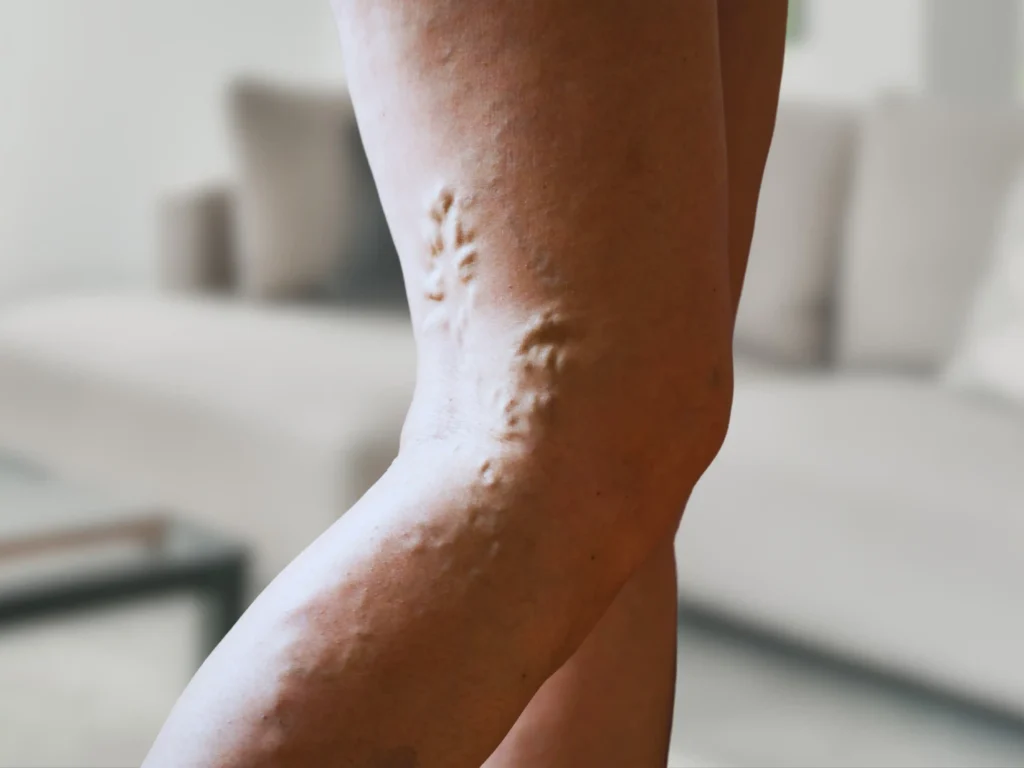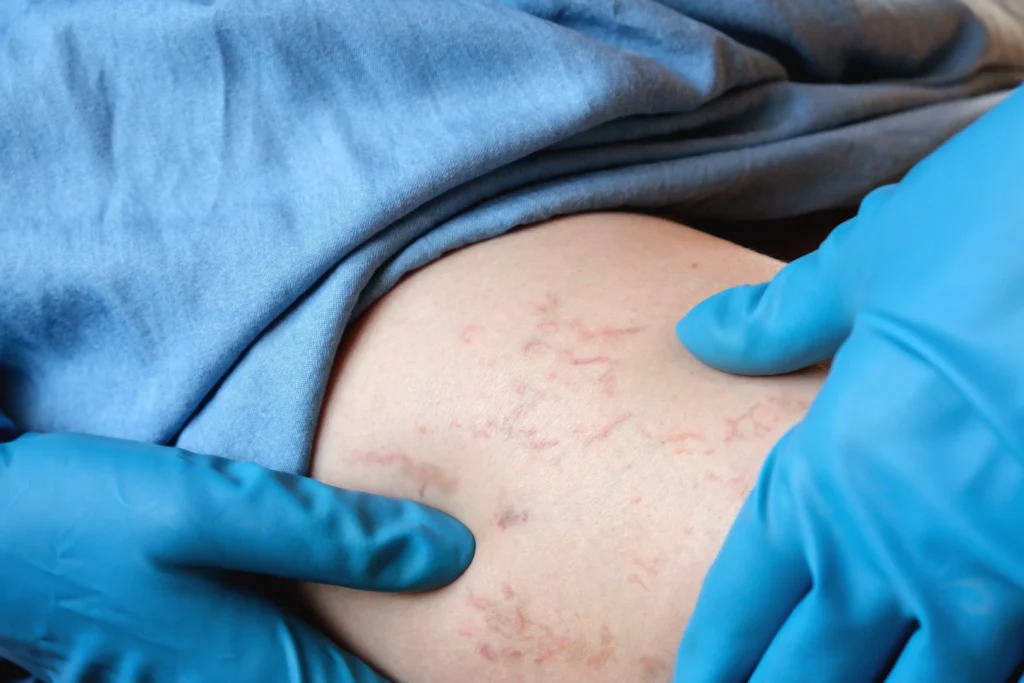What is the Best Treatment for Varicose Veins? Find Out Now!
You’ve noticed unsightly blue or purple veins snaking up your legs, causing discomfort and self-consciousness. Maybe you feel a heaviness or aching at the end of a long day on your feet. You wonder whether it’s time to seek treatment but aren’t sure where to start. These visible veins might be more than a cosmetic issue. Varicose veins can indicate an underlying vein disease known as chronic venous insufficiency, a condition that can worsen if left untreated.
At Vein Treatment, we specialize in providing minimally invasive treatments that target both the appearance and the root cause of varicose veins. But with so many options available, you might be wondering, “What is the best treatment for varicose veins?” Our vein doctors provide cutting-edge, minimally invasive vein treatments to address the root cause of your vein problems. Read on to discover the most effective treatments and learn how to prevent varicose veins from recurring in the future.
Endovenous Laser Ablation (EVLA)
Endovenous Laser Ablation (EVLA) is one of the most effective and popular varicose veins treatments available today. This minimally invasive procedure uses laser energy to close off the damaged veins, rerouting blood flow to healthier veins. EVLA is performed in the comfort of our state-of-the-art vein treatment clinics and takes less than an hour to complete.
Benefits of Endovenous Laser Ablation (EVLA):
- Minimally invasive, no large incisions
- Performed under local anesthesia
- Quick recovery time, typically within a day or two
- Effective for treating large varicose veins
- Immediate symptom relief (e.g., heaviness, aching)
Radiofrequency Ablation (RFA)
Radiofrequency Ablation (RFA) is another advanced vein treatment for varicose veins. Similar to EVLA, this procedure uses radiofrequency energy instead of lasers to heat the vein walls, causing them to collapse and seal shut. RFA is particularly suited for patients with larger varicose veins or more extensive venous insufficiency.
Benefits of Radiofrequency Ablation (RFA):
- Minimally invasive with no need for general anesthesia
- Quick recovery, allowing a return to normal activities within days
- Minimal discomfort during and after the procedure
- High success rates in long-term vein closure
- Effective for treating chronic venous insufficiency
VenaSeal
VenaSeal is a revolutionary, non-thermal treatment for varicose veins. Instead of using heat, VenaSeal involves injecting a medical adhesive into the affected vein to seal it shut. This treatment is especially suitable for patients who may not be ideal candidates for thermal treatments like RFA. It’s performed in our cutting-edge vein centers across the U.S.
Benefits of VenaSeal:
- Non-thermal, non-tumescent procedure (no need for anesthesia)
- Minimal post-treatment bruising or discomfort
- Immediate return to normal activities
- No need for compression stockings post-treatment
- Excellent cosmetic results
ClariVein
ClariVein is a hybrid treatment that combines mechanical and chemical methods to close damaged veins. A rotating catheter delivers a sclerosing agent to the vein’s walls, sealing the vein without the need for heat or large incisions. ClariVein is often used for patients with tortuous varicose veins or when thermal treatments aren’t recommended.
Benefits of ClariVein:
- Minimally invasive with no heat or anesthesia required
- Quick recovery time with little to no downtime
- Ideal for treating both large and small varicose veins
- Reduces risk of nerve injury in certain areas
- No need for compression stockings post-procedure
Ambulatory Phlebectomy
For larger, bulging varicose veins, ambulatory phlebectomy is often the best solution. This procedure involves making tiny incisions in the skin to physically remove the damaged veins. Although it sounds invasive, ambulatory phlebectomy is performed under local anesthesia and typically leaves only minimal scarring.
Benefits of Ambulatory Phlebectomy:
- Effective for large, visible varicose veins
- Performed under local anesthesia in a clinic setting
- Immediate cosmetic improvement
- Minimal scarring due to tiny incisions
- Fast recovery with minor post-procedure discomfort
Sclerotherapy
Sclerotherapy is a widely used treatment for spider veins and small varicose veins. During the procedure, a sclerosing solution is injected into the damaged veins, causing them to collapse and eventually disappear. Sclerotherapy is highly effective for treating surface-level veins and can be performed alongside other treatments to address underlying venous insufficiency.
Benefits of Sclerotherapy:
- Minimally invasive, performed in-office
- Quick and virtually painless
- No anesthesia required
- Excellent cosmetic results for spider veins and smaller varicose veins
- Can be combined with other treatments for comprehensive vein care
How to Prevent Varicose Veins
How to prevent varicose veins? While varicose veins can be effectively treated, it’s always best to take preventive measures to reduce the risk of developing new veins or worsening existing ones. Incorporating a few lifestyle changes can significantly impact your vein health.
- Stay Active: Regular physical activity encourages blood flow and strengthens your leg muscles, which helps prevent blood from pooling in your veins.
- Maintain a Healthy Weight: Carrying excess weight puts added pressure on your veins, increasing the likelihood of varicose veins. Maintaining a healthy weight can help reduce this strain.
- Avoid Prolonged Sitting or Standing: If your job requires long periods of sitting or standing, make sure to take frequent breaks to move around. Flex your legs, stretch, and change positions to keep blood circulating.
- Elevate Your Legs: When resting, elevate your legs to improve circulation and reduce pressure on your veins.
- Wear Compression Stockings: If you are prone to varicose veins, consider wearing compression stockings. These specialized stockings apply pressure to your legs, helping veins move blood more efficiently.
Are Vein Treatments Covered by Insurance?
One of the most common questions is whether varicose vein treatments are covered by insurance. The answer is yes—most vein treatments are covered if deemed medically necessary. Varicose veins caused by chronic venous insufficiency often qualify for insurance coverage, especially when they result in symptoms like pain, swelling, or leg ulcers.
While spider veins are typically viewed as a cosmetic issue, the treatment of the underlying venous insufficiency is covered by insurance. Therefore, if you are diagnosed with venous insufficiency, even procedures like sclerotherapy may be covered by your plan.







